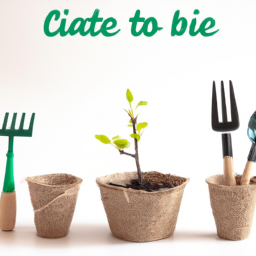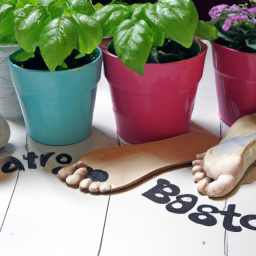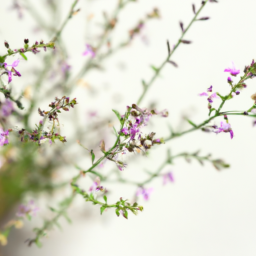
Hey there nature enthusiasts! Are you interested in learning about the incredible impact native plants can have on our local ecosystems? Well, you’ve come to the right place! In this blog post, we will delve into the fascinating world of native plants for local ecosystems and how they play a crucial role in boosting biodiversity. So, grab a cup of tea, settle in, and let’s explore the wonders of our natural world together!
Importance of Native Plants in Local Ecosystems: Enhancing Biodiversity and Ecological Balance
Native plants play a crucial role in maintaining the delicate balance of local ecosystems and are essential for boosting biodiversity. These plants have evolved over thousands of years to adapt to specific climates, soils, and environmental conditions, making them uniquely suited to support a wide range of native wildlife, including insects, birds, and mammals. By incorporating native plants into our landscapes, we can create thriving habitats that provide food, shelter, and nesting sites for various species, ultimately contributing to the overall health and resilience of our environment.
When we choose to cultivate native plants, we are essentially preserving the natural heritage of our region. These plants have coexisted with local wildlife for centuries, forming intricate ecological relationships that are vital for the functioning of our ecosystems. By replacing non-native plants with indigenous ones, we can help restore and protect these relationships, ensuring the survival of native species and maintaining the ecological balance.
One of the key advantages of native plants is their ability to support pollinators, such as bees, butterflies, and hummingbirds. These crucial insects and birds rely on native plants for nectar, pollen, and habitat, which are essential for their survival. By planting a diverse array of native flowers, shrubs, and trees, we can create vibrant pollinator gardens that not only enhance the beauty of our landscapes but also provide vital resources for these important creatures.
The Benefits of Native Plants for Local Ecosystems
1. Enhancing Biodiversity: Native plants provide a diverse range of habitats and food sources for local wildlife, contributing to the overall biodiversity of an ecosystem. By supporting a wide variety of species, native plants help maintain the delicate balance of nature and prevent the dominance of invasive species.
2. Conservation of Water and Soil: Native plants are well-adapted to local environmental conditions, including rainfall patterns and soil types. Their deep root systems help prevent soil erosion and improve water infiltration, reducing the risk of flooding and improving water quality.
3. Low Maintenance and Cost-Effective: Once established, native plants generally require less maintenance, including watering, fertilizing, and pest control, compared to non-native plants. This not only saves time and effort but also reduces the need for synthetic chemicals, making it a more environmentally friendly and cost-effective choice.
How to Incorporate Native Plants into Your Local Ecosystem
1. Research Native Plant Species: Start by researching native plant species that are suitable for your specific region. Consider factors such as sunlight requirements, soil type, and water availability to ensure the plants will thrive in your local ecosystem.
2. Plan Your Landscape: Assess your landscape and identify areas where you can incorporate native plants. Consider creating different zones, such as meadows, woodland areas, or wetland gardens, to provide a variety of habitats for wildlife.
3. Choose a Variety of Native Plants: Include a diverse selection of native plants in your landscape to support a wide range of wildlife. Choose plants with different blooming periods to provide a continuous source of nectar and pollen throughout the year.
4. Create Wildlife-friendly Features: Incorporate features such as bird feeders, birdhouses, and birdbaths to attract and support local bird populations. Additionally, consider leaving dead trees or fallen logs as habitat for insects and small mammals.
5. Practice Sustainable Gardening: Avoid the use of synthetic fertilizers, herbicides, and pesticides, as these can harm native plants and wildlife. Instead, opt for organic alternatives and integrated pest management techniques to maintain a healthy and balanced ecosystem.
6. Educate Others: Spread awareness about the importance of native plants for local ecosystems and encourage others to incorporate them into their landscapes. By sharing knowledge and experiences, we can collectively make a significant impact on biodiversity conservation.
In conclusion, incorporating native plants into our local ecosystems is a powerful way to boost biodiversity and promote ecological balance. These plants provide essential resources for native wildlife, enhance the beauty of our landscapes, and contribute to the overall health and resilience of our environment. By following the steps outlined above, we can all play a role in preserving and restoring our natural heritage for future generations to enjoy.
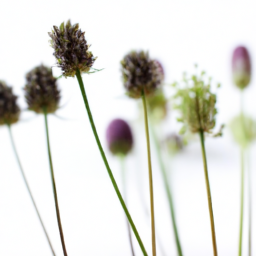
Choosing the Right Native Plants for Your Local Ecosystem: Factors to Consider for Successful Biodiversity Boosting
Native plants play a crucial role in supporting local ecosystems and promoting biodiversity. By choosing the right native plants for your area, you can contribute to the health and sustainability of your environment. In this guide, we will explore the factors you need to consider when selecting native plants for your local ecosystem, ensuring a successful biodiversity boost.
Understanding Your Local Ecosystem
Before diving into the process of selecting native plants, it is essential to have a good understanding of your local ecosystem. Every region has its unique climate, soil composition, and native species. By familiarizing yourself with these factors, you can make informed decisions about which plants will thrive and provide the greatest benefit to your ecosystem.
Start by researching the native plants that naturally occur in your area. Look for information on their growth habits, preferred soil types, and water requirements. Understanding the natural conditions in which these plants thrive will help you create a suitable habitat for them.
Additionally, observe the existing flora and fauna in your local ecosystem. Take note of the types of plants that are already present and the wildlife that depends on them. This observation will give you valuable insights into the specific needs of your ecosystem and help you choose plants that will complement and enhance the existing biodiversity.
Matching Plants to Your Local Conditions
Once you have a good understanding of your local ecosystem, it’s time to start selecting native plants that are well-suited to your specific conditions. Consider the following factors when making your choices:
1. Climate:
The climate of your region plays a significant role in determining which native plants will thrive. Some plants are adapted to hot and dry conditions, while others prefer cooler and wetter climates. Take into account the average temperature, rainfall patterns, and seasonal variations in your area. Choose plants that are well-adapted to your climate to ensure their long-term survival.
2. Soil Type:
The soil composition in your local ecosystem is another critical factor to consider. Some plants prefer well-drained sandy soil, while others thrive in heavy clay or loamy soil. Test your soil to determine its pH level, nutrient content, and drainage characteristics. This information will help you select plants that are best suited for your soil type, ensuring they can establish strong root systems and grow successfully.
3. Sunlight Exposure:
Native plants have varying sunlight requirements. Some thrive in full sun, while others prefer partial or full shade. Observe the sunlight patterns in your garden throughout the day and identify areas with different levels of exposure. Choose plants that match the available sunlight in each area to maximize their growth and overall health.
Creating a Balanced Ecosystem
When selecting native plants for your local ecosystem, it is essential to aim for a balanced and diverse plant community. A diverse plant community supports a wide range of wildlife, including insects, birds, and mammals, which contribute to the overall biodiversity of your area. Consider the following tips to create a balanced ecosystem:
1. Plant for all seasons: Select a mix of native plants that bloom and provide food sources throughout the year. This ensures a continuous supply of nectar, pollen, and seeds for various wildlife species, supporting their survival and reproduction.
2. Provide different habitats: Choose plants that offer a variety of habitats, such as dense shrubs for nesting birds, flowering plants for pollinators, and grasses for ground-dwelling insects. By providing different habitats, you can attract a wide range of wildlife to your garden.
3. Avoid invasive species: Be cautious not to introduce invasive plant species into your local ecosystem. Invasive plants can outcompete native species, disrupt natural ecosystems, and harm biodiversity. Research your chosen plants to ensure they are not invasive in your area.
By following these guidelines and considering the unique factors of your local ecosystem, you can choose the right native plants to boost biodiversity successfully. Remember, every small step towards supporting your local ecosystem contributes to the overall health and sustainability of our planet.
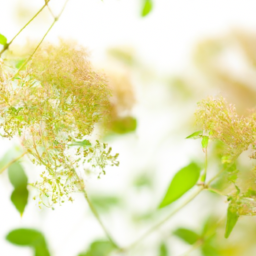
Creating a Native Plant Garden: Tips and Techniques for Promoting Biodiversity in Your Local Ecosystem
Welcome to the world of native plants and the incredible impact they can have on boosting biodiversity in your local ecosystem. Creating a native plant garden is not only a beautiful addition to your surroundings, but it also plays a crucial role in supporting the local wildlife and preserving the delicate balance of nature. In this guide, we will take you through the step-by-step process of creating a native plant garden, providing you with tips and techniques to maximize the biodiversity in your area.
Understanding the Importance of Native Plants
Before we dive into the practical aspects of creating a native plant garden, let’s first understand why native plants are so vital for promoting biodiversity. Native plants are species that have evolved and adapted to specific regions over thousands of years. They have developed intricate relationships with local wildlife, including insects, birds, and mammals, providing them with food, shelter, and breeding grounds.
By using native plants in your garden, you are essentially creating a habitat that supports and sustains the local ecosystem. These plants provide a source of nectar and pollen for pollinators like bees and butterflies, which in turn help in the reproduction of flowering plants. Native plants also attract a diverse range of insects, which serve as a vital food source for birds and other wildlife. In essence, native plants act as the foundation for a thriving and interconnected web of life.
Now that we understand the importance of native plants, let’s move on to the practical steps involved in creating a native plant garden.
Step 1: Assessing Your Site
Before you start planting, it’s essential to assess your site and understand its unique characteristics. Factors such as soil type, sunlight exposure, and moisture levels will determine the types of native plants that will thrive in your garden. Take some time to observe your site throughout the day, noting the areas that receive full sun, partial shade, or full shade. This will help you select the appropriate plants for each area.
Additionally, consider the existing vegetation and any invasive species that may be present. Removing invasive plants is crucial to create space for native plants to flourish. It’s also important to evaluate the drainage patterns of your site to ensure that water does not accumulate in certain areas, as this can impact plant health.
Once you have assessed your site, you can move on to the next step: selecting the right native plants.
Step 2: Selecting Native Plants
Choosing the right native plants for your garden is essential to create a diverse and resilient ecosystem. Consider selecting a mix of plant species that provide food and shelter throughout the year, ensuring a continuous supply of resources for wildlife. Native trees, shrubs, wildflowers, and grasses all play different roles in supporting biodiversity, so aim for a variety of species.
When selecting native plants, look for species that are well-suited to your site’s conditions, including soil type, sunlight exposure, and moisture levels. Native plant nurseries and local gardening centers are excellent resources for finding region-specific species. Additionally, consult with local experts or join native plant societies to gain insights into the best plants for your area.
Remember to choose native plants that are not invasive themselves. Some native plants can become invasive in certain regions, outcompeting other species and disrupting the balance of the ecosystem. Research the native plants you are considering to ensure they are suitable for your specific location.
Step 3: Planting and Maintenance
Once you have selected the native plants for your garden, it’s time to start planting! Begin by preparing the soil, removing any weeds or grasses that may compete with the newly planted species. Loosen the soil and add organic matter, such as compost, to improve its fertility and drainage.
When planting, follow the specific requirements of each plant, including the recommended spacing and depth. Water the plants thoroughly after planting and continue to provide adequate moisture during their establishment period. Mulching around the plants can help retain moisture, suppress weeds, and regulate soil temperature.
Regular maintenance is crucial to ensure the long-term success of your native plant garden. Monitor the plants for signs of pests or diseases and take appropriate action if necessary. Remove any weeds that may emerge, as they can compete for resources with the native plants. Additionally, consider incorporating practices such as rainwater harvesting, composting, and natural pest control to further enhance the sustainability of your garden.
Remember, creating a native plant garden is a journey that requires patience and ongoing care. As the plants establish and grow, you will witness the beauty and abundance of wildlife that they attract, contributing to the overall biodiversity of your local ecosystem.
So, go ahead and embark on this rewarding endeavor of creating a native plant garden. By doing so, you will not only be enhancing the beauty of your surroundings but also making a significant contribution to the preservation of our natural heritage.
In a Nutshell
Are you looking to make a positive impact on your local environment? One way you can do this is by incorporating native plants into your garden or outdoor space. By choosing plants that are native to your area, you can help boost biodiversity and support the local ecosystem.
Native plants are those that have naturally evolved in a specific region over thousands of years. They have adapted to the local climate, soil conditions, and wildlife, making them well-suited for the area. When you plant native species, you are providing a habitat and food source for local birds, insects, and other wildlife. This, in turn, helps to maintain a healthy and diverse ecosystem. Native plants also require less water, fertilizer, and pesticides, making them a sustainable and low-maintenance option for your garden. So, whether you have a small backyard or a larger piece of land, consider incorporating native plants to create a beautiful and thriving ecosystem right at your doorstep.
Common Questions and Answers:
Q1: What are native plants?
A1: Native plants are plants that naturally occur in a specific region or ecosystem without human intervention. They have evolved over time to adapt to the local climate, soil, and wildlife, making them well-suited for their environment.
Q2: Why are native plants important for local ecosystems?
A2: Native plants play a crucial role in local ecosystems by providing food and habitat for native wildlife, including insects, birds, and mammals. They also help maintain the balance of the ecosystem by supporting pollinators, improving soil health, and preventing erosion.
Q3: How do native plants boost biodiversity?
A3: Native plants are key contributors to biodiversity as they support a wide range of native species. By providing food and shelter, native plants attract and sustain a diverse array of wildlife, including beneficial insects, birds, and small mammals. This diversity strengthens the overall health and resilience of the ecosystem.
Q4: How can I incorporate native plants into my garden or landscape?
A4: To incorporate native plants into your garden or landscape, start by researching the native plants that are indigenous to your specific region. Consider factors such as sunlight, soil type, and moisture levels to choose plants that will thrive in your area. Purchase native plants from local nurseries or participate in native plant sales organized by conservation organizations. Plant them in appropriate locations, provide necessary care, and watch as they attract local wildlife and enhance the beauty of your surroundings.
Q5: Are there any resources available to help me identify and learn about native plants in my area?
A5: Yes, there are several resources available to help you identify and learn about native plants in your area. Local botanical gardens, nature centers, and conservation organizations often offer workshops, guided hikes, and educational materials on native plants. Online databases and mobile apps also exist, allowing you to search for native plants by region and access detailed information about their characteristics and benefits.
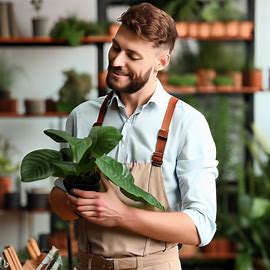
Alex Turner is a sustainable gardening advocate and the founder of an acclaimed indoor gardening blog. With a focus on eco-friendly practices and urban sustainability, Alex combines his background in environmental studies with his love for plants to educate readers on mindful indoor gardening. His work highlights the importance of nurturing both plants and the planet.

